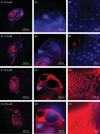Automated Image-Based Fluorescence Screening of Mitochondrial Membrane Potential in Daphnia magna: An Advanced Ecotoxicological Testing Tool
- PMID: 39190186
- PMCID: PMC11393999
- DOI: 10.1021/acs.est.4c02897
Automated Image-Based Fluorescence Screening of Mitochondrial Membrane Potential in Daphnia magna: An Advanced Ecotoxicological Testing Tool
Erratum in
-
Correction to "Automated Image-Based Fluorescence Screening of Mitochondrial Membrane Potential in Daphnia magna: An Advanced Ecotoxicological Testing Tool".Environ Sci Technol. 2025 Jun 10;59(22):11426. doi: 10.1021/acs.est.5c05506. Epub 2025 May 25. Environ Sci Technol. 2025. PMID: 40415351 Free PMC article. No abstract available.
Abstract
This study demonstrated the strengths of in vivo molecular staining coupled with automated imaging analysis in Daphnia magna. A multiwell plate protocol was developed to assess mitochondrial membrane potential using the JC-1 dye. The suitability of five common anesthetics was initially tested, and 5% ethanol performed best in terms of anesthetic effects and healthy recovery. The staining conditions were optimized to 30 min staining with 2 μM JC-1 for best J-aggregate formation. The protocol was validated with the model compound carbonyl cyanide 3-chlorophenylhydrazone (CCCP) and used to measure the effect of four environmental contaminants, 2,4-dinitrophenol, triclosan, n-(1,3-dimethylbutyl)-N'-phenyl-p-phenylenediamine (6PPD), and ibuprofen, on mitochondrial health. Test organisms were imaged using an automated confocal microscope, and fluorescence intensities were automatically quantified. The effect concentrations for CCCP were lower by a factor of 30 compared with the traditional OECD 202 acute toxicity test. Mitochondrial effects were also detected at lower concentrations for all tested environmental contaminants compared to the OCED 202 test. For 2,4-dinitrophenol, mitochondria effects were detectable after 2 h exposure to environmentally relevant concentrations and predicted organism death was observed after 24 h. The high sensitivity and time efficiency of this novel automated imaging method make it a valuable tool for advancing ecotoxicological testing.
Keywords: 2,4-dinitrophenol; 6PPD; NAMs; carbonyl cyanide 3-chlorophenylhydrazone; high-content imaging; high-content screening, JC-1; ibuprofen; pharmaceuticals, ecotoxicology; triclosan.
Conflict of interest statement
The authors declare no competing financial interest.
Figures





References
-
- Alpizar F.; Backhaus T.; Decker N.; Eilks I.; Escobar-Pemberthy N.; Fantke P.; Geiser K.; Ivanova M.; Jolliet O.; Kim H.-S.. UN Environment Global Chemicals Outlook II—From Legacies to Innovative Solutions: Implementing the 2030 Agenda for Sustainable Development, 2019.
-
- Karlsson O. Chemical Safety and the Exposome. Emerging Contaminants 2023, 9 (2), 100225 10.1016/j.emcon.2023.100225. - DOI
-
- Krewski D.; Andersen M. E.; Tyshenko M. G.; Krishnan K.; Hartung T.; Boekelheide K.; Wambaugh J. F.; Jones D.; Whelan M.; Thomas R.; Yauk C.; Barton-Maclaren T.; Cote I. Toxicity Testing in the 21st Century: Progress in the Past Decade and Future Perspectives. Arch. Toxicol. 2020, 94 (1), 1–58. 10.1007/s00204-019-02613-4. - DOI - PubMed
-
- OECD. Test No. 211: Daphnia Magna Reproduction Test; OECD Guidelines for the Testing of Chemicals, Section 2; OECD, 2012. 10.1787/9789264185203-en. - DOI
-
- OECD. Test No. 202: Daphnia Sp. Acute Immobilisation Test; OECD Guidelines for the Testing of Chemicals, Section 2; OECD, 2004. 10.1787/9789264069947-en. - DOI
MeSH terms
Substances
LinkOut - more resources
Full Text Sources

